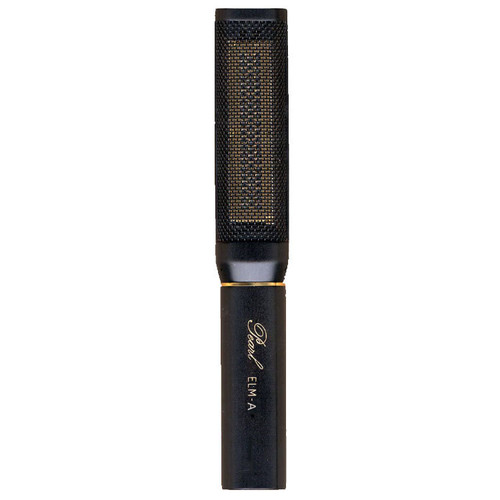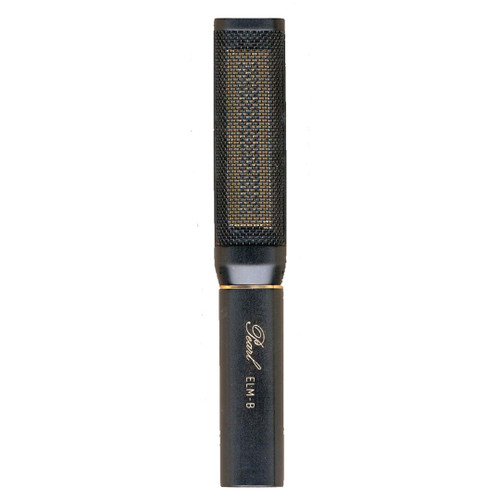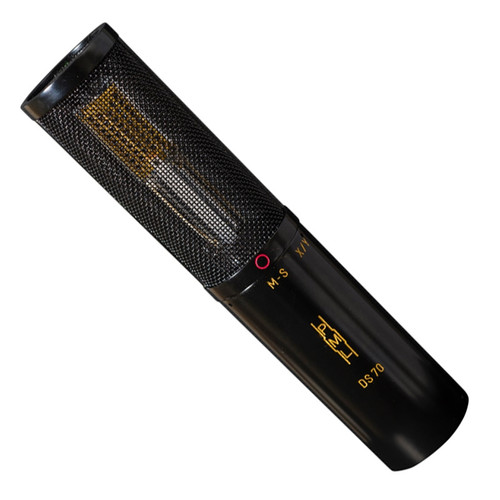The Pearl Microphones ELM-A Microphone provides an extremely unique 2-channel output solution for specific recording situations. With Pearl's unique rectangular capsule and multi-pattern polar characteristics makes for a truly unique and stellar sounding microphone.
The Pearl Microphones ELM-A Microphone's linear capsule has more than twice the surface area of large-diameter round capsules. This gives excellent signal-to-noise ratio and a near resonance-free frequency response. The Pearl Microphones ELM-A's speciality is its polar pattern that is a normal cardioid horizontally and much narrower vertically. The Pearl Microphones ELM-A Microphone has two separate outputs via a 5 pin XLR connector. Both outputs deliver independent cardioids, one from each membrane of the dual membrane capsule, i.e. "Back to Back" output or 180 degrees stereo. Both sides can be used simultaneously or independently. When the Pearl Microphones ELM-A Microphone is connected to two inputs at the console/DAW, an omni, figure-of-eight or cardioid pattern can be obtained by using the pan pots and phase shifting of one channel.
The Pearl Microphones ELM-A Microphone is finished in piano black ED lacquer with a white logo, ring and engraved model number.
Pearl Microphones ELM-A Microphone Features
- Extremely unique 2-channel output solution for specific recording situations
- Two separate outputs via a 5 pin XLR connector
- Pearl's unique rectangular capsule
- Excellent signal-to-noise ratio
- Near resonance-free frequency response
- Finished in piano black ED lacquer
- White logo, ring and engraved model number
Pearl Microphones ELM-A Microphone Specifications
- Polar Pattern: Cardioid, Omni, Figure-of-eight
- Sensitivity: 22mV/Pa
- Frequency Response: 20Hz - 25kHz
- Impedance: 100 ohms
- Operating Voltage: 48 volts
- Rec. Load Imp: 1k ohms
- Current Consumption: 3.5 mA
- Self Noise: 11 dBA
- Max SPL: 126 dB
- Connector: 5-pin XLR
- Dimensions: 192 x ø32 mm/28mm
- Weight: 305 g
Pearl Microphones ELM-A Microphone Includes
- ELM-A Microphone
- Wooden Box
- Pearl Microphones 1930 Mount
- Individual Frequency Graph
1 Review Hide Reviews Show Reviews
-
Incredible desert island microphone
Jun 14th 2021I was advised to get a stereo pair of ELM-A's by an ethnomusicologist friend, as a desert island pair that, along with a mixpre-6 ii, I will be able to take with me throughout the world, recording in opportune places. I wanted a mic that would give me all the polar patterns I needed, and I had gotten to the point of mostly recording with ribbons, such as royer 122 and AEA R-88a. These are great mics but too fragile for this kind of travel. The ELM-A is blowing me away, with its more extended high end than ribbons, but ribbon mic like smoothing of transients, and infinitely variable polar pattern via the 2 separate outputs per mic, and better rejection in the vertical plane... It's really my ideal mic pair... I find myself not feeling a need for other mics except for spots. I record mostly folk music and I am finding these a fantastic main stereo pair and also good close mics if you aim them correctly. If one is interested in hearing the sound of rectangular diaphragm mics, they should look up Kavi Alexander's recordings. Front end has been very communicative with answering my questions, and reached out to me when there was a problem with postage. I have lots of getting to know with these microphones, but I am very much looking forward to that process. With the stereo pair, I can set one up with it's capsule directly behind the other upside down facing left, and then reverse the polarity of channel 2 of that mic, and I have an infinitely variable mid side setup. By changing the polarity of the rear of the mid mic I get fig 8 mid side, or omni with same polarity and equal volume, and cardioid with the rear muted. You can even record in stereo with one mic facing left and right with the two channels panned left and right, Very happy.
Write a Review












 Sign Up for exclusive sales and offers!
Sign Up for exclusive sales and offers!